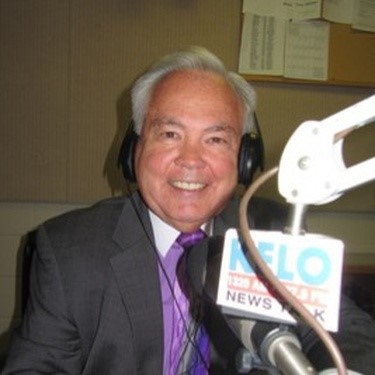 Bill Zortman (KELO/KELQ, Sioux Falls, South Dakota) grew up as a farm kid in Onawa, Iowa, feeding sheep, hogs, and cattle with his family.
Bill Zortman (KELO/KELQ, Sioux Falls, South Dakota) grew up as a farm kid in Onawa, Iowa, feeding sheep, hogs, and cattle with his family.
“I started writing for my hometown newspapers, and my writings won me a Hearst-Mills Scholarship to the University of Iowa.”
After two years as a Hawkeye, he left school to work for a small-town radio station for 16 weeks before moving on to KTIV-TV in Sioux City, where he did the morning news and live weather in front of a map (not a green wall). That was in 1967. In January 1968, Zortman’s Air Guard Unit was called to active duty.
“While many went to Vietnam and Korea, 125 of us went to Clovis, New Mexico.”
He lived in the south for 31 years before returning to the Midwest in August 2000. ln January 1970, Zortman was hired as the Man in Motion for KVII-TV in Amarillo, Texas. His job was to cover the area from Lubbock, Texas, to Liberal, Kansas, from Sayre, Oklahoma to Clovis, Tucumcari, and Clayton, New Mexico. He created a stringer system of individuals who would report and film local news events.
“In two years, I had 40 contributors who had bought their own cameras and served as our Pro News area reporters. When I arrived in Amarillo, we had only 7 percent of the news audience. It made Stanley Marsh III, who owned the station very happy that by the time I left in August 1980 to go to sister station KVIA-TV in El Paso, that we had reached nearly 70 percent of the audience.”
While in Amarillo, he had a chance to become a farm reporter (standing in the wheat fields of the Texas Panhandle); and in more than two years, he produced six or seven reports for Orion Samuelson.
“I learned to love doing the stories, seeing them on the national stage, and becoming somewhat of a farm reporter. I became one of the last UPI Texas Broadcasters Association Presidents. I hosted one of the statewide debates that elected the first Republican governor in modern times in the Lone Star State.”
In 1984, Zortman was hired as vice president of news operations for Beam Communications. It was at WDAM-TV in Hattiesburg, Mississippi. His duties included news supervision not only there but also in Tuscaloosa, Alabama; Traverse City, Michigan; and Yuma, Arizona. In 1993, he became news director of WAKA-TV in Montgomery, Alabama. The CBS Affiliate was licensed to Selma, as well.
“All along the way, I was involved in news, farm news, politics, and community affairs,” he said. “We decided in 1995 to do an anniversary on the march from Selma to Montgomery on Bloody Sunday. I organized and anchored a two-hour show from Selma with those on both sides that were a part of the unforgettable march.”
Next, he was sent to Sioux Falls to take over as general manager of KSFY-TV until a new manager could be hired.
“After I got here, they really wanted me to stay, but I opted to go back to Montgomery and eventually was dispatched to Knoxville, Tennessee, to set up a Fox News newscast inside the CBS Station’s newsroom.”
However, Zortman did return to South Dakota where for two years he ran the Nakota Red Cross Chapter for Nebraska and South Dakota. During that time, 911 happened.
“Virtually, all the funds we were raising were going to New York and Washington, D.C. When they ran out of money, I decided to turn to real estate.
Along the way, I was asked to do a talk show for KELO-AM radio. It would be a business show. Later, a farm show was added; and today, I’ve done almost 2,800 shows. With my time in news, it was different to be a business and farm advocate. I’m still a businessman (real-estate agent) doing a business show. With my farm background, it’s easy to be an advocate for agricultural organizations and work on bringing them together. I’ve done my show from Washington, D.C., on a manufacturing trip to Kentucky, from NAFB, and from farm shows in Iowa, Minnesota, and the  Dakotas. It’s not about me. It’s about our guests and what they need to know and how our listeners can understand issues a little better. Agriculture secretaries in the Dakotas, Minnesota, Iowa, and Nebraska talk with us. We use farmers doing live reports in combines and planters. I ride along for planting and harvesting, too. In addition, we promote Groundworks in South Dakota. Today, they have 6,000 fourth graders who tour farms online. The FFA of South Dakota shares its leaders with community events. We have planned some broadcast training I’ll do with those leaders in 2020.”
Dakotas. It’s not about me. It’s about our guests and what they need to know and how our listeners can understand issues a little better. Agriculture secretaries in the Dakotas, Minnesota, Iowa, and Nebraska talk with us. We use farmers doing live reports in combines and planters. I ride along for planting and harvesting, too. In addition, we promote Groundworks in South Dakota. Today, they have 6,000 fourth graders who tour farms online. The FFA of South Dakota shares its leaders with community events. We have planned some broadcast training I’ll do with those leaders in 2020.”
The Sioux Falls Area Chamber has a leadership class each year. This year, the 32 members of the class will join Zortman for a live interview on his ag or business show. They are becoming his correspondents for the show.
“You might be surprised how much the businesses and those going through the class appreciate the opportunity to communicate with us and their own companies.”
At a time when much of our communications today is left- or right-biased, it is nice to do a show that allows me to be an advocate for agriculture and business. In my show, I’m fortunate to include two farm directors with Midwest Communications: Rick Shields in Kalamazoo, Michigan (who worked with me in the Texas Panhandle), and Sarah Heinrich with KFGO in Fargo, North Dakota.
I’ve been in the business since 1966; and even at 73, I enjoy being able to make a difference and define what my hour-long shows are. If you are going to be an advocate, why not agriculture? Why not business? Why not something that can make a difference,” Zortman concluded.
Zortman’s wife, Carolyn, retired this year after 43 years as a GI nurse.
“Carolyn and I have three kids, 10 grandkids, and two great grandkids. Along the way, we helped build and serve on seven parish councils. We can say our prayers were answered!”
